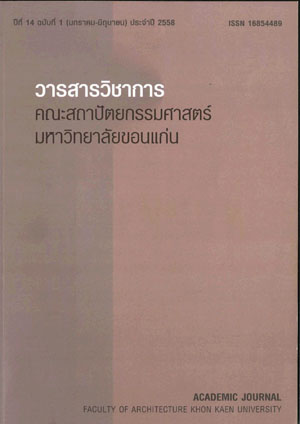การออกแบบและพัฒนาผลิตภัณฑ์จากขี้เลื่อยไม้ยางพารา
คำสำคัญ:
การออกแบบและพัฒนาผลิตภัณฑ์, ขี้เลื่อยไม้ยางพารา, วัสดุผสม, วัสดุหลัก, Product design and development, Rubber tree sawdust, Composite materials, Main materialบทคัดย่อ
การวิจัยครั้งนี้ มีวัตถุประสงค์ เพื่อออกแบบและพัฒนาผลิตภัณฑ์จากแผ่นวัสดุผสมระหว่างวัสดุหลัก กับวัสดุเสริมแรงจากขี้เลื่อยไม้ยางพารา ตามความต้องการของผู้ซื้องานหัตถกรรม ประชากรและกลุ่มตัวอย่างที่ใช้ใน การวิจัยครั้งนี้คือ กลุ่มนักท่องเที่ยวผู้ซื้องานหัตถกรรมในจังหวัดเชียงใหม่ จำนวน 60 คน เครื่องมือที่ใช้ในการวิจัย เป็นแบบสอบถาม การวิเคราะห์ข้อมูลใช้ค่าร้อยละ ผลการวิจัยสรุปได้ 2 ส่วน ดังนี้ 1. การวิเคราะห์ข้อมูลความต้องการ ของผู้ซื้องานหัตถกรรมพบว่า ผู้ซื้อเลือกงานหัตถกรรมประเภทของตกแต่งบ้าน รองลงมาเป็นประเภทของใช้ และ ประเภทของที่ระลึก ตามลำดับ ผู้ซื้อส่วนใหญ่มีความต้องการจุดเด่นของงานหัตถกรรมในด้านความประณีตสวยงาม รูปแบบงานหัตถกรรมมีความเป็นเอกลักษณ์เฉพาะถิ่น ผลิตจากวัสดุธรรมชาติโดยมีสีและลักษณะลวดลายบนงาน หัตถกรรมที่ใช้ลวดลายจากธรรมชาติ ลวดลายไทย ซึ่งได้ข้อเสนอแนะว่างานหัตถกรรมควรผลิตจากวัสดุธรรมชาติใน ท้องถิ่นที่เป็นมิตรต่อสิ่งแวดล้อม 2. ขั้นตอนการออกแบบและพัฒนาผลิตภัณฑ์จากขี้เลื่อยไม้ยางพารา พบว่า 1) ด้าน การสร้างกรอบแนวคิดการออกแบบและพัฒนาผลิตภัณฑ์ จะต้องคำนึงถึงปัจจัยที่มีผลต่องานออกแบบ 2) ด้านวัสดุ และกรรมวิธีการผลิต จะต้องเข้าใจลักษณะและขนาดของแผ่นวัสดุผสมขี้เลื่อยไม้ยางพารา ที่จะนำมาออกแบบและ ผลิตเป็นชิ้นงานผลิตภัณฑ์ 3) ด้านข้อมูลความต้องการของผู้ซื้องานหัตถกรรม เพื่อใช้เป็นข้อมูลในการออกแบบและ พัฒนาผลิตภัณฑ์ให้สอดคล้องกับความต้องการของผู้ซื้อ ซึ่งข้อมูลทั้ง 3 ด้านนี้นำมาใช้สร้างแนวความคดิ และออกแบบ ภาพร่างผลิตภัณฑ์ ประเภทของตกแต่งบ้าน ของใช้และของที่ระลึก พร้อมกับการสร้างหุ่นจำลองเพื่องานออกแบบ
A Product Design and Development of Rubber Tree Sawdust
Tragoonphan Patcharametha
The research aimed to design and develop the products made from the composite material, formed by main material and rubber tree sawdust, which made according to customers’ requirement. The population and the sample group were 60 handicraft buyers who were tourists in Chiangmai. The data were collected by using questionnaire and analyzed by percentage. The results were as follows: 1. The analysis of the customers’ requirement showed the purposes to purchase the product ranked the highest to the lowest preferences - from home decoration items, house wares, and souvenirs respectively. Most of the customers required that the products should be well designed and represent local unique quality. They should also be made from natural material in authentic color. The natural pattern was preferred more than Thai patterns. It was recommended that the products should be made as environment friendly using natural and local materials. 2. The research on the product design and development process using rubber tree sawdust revealed that 1) the concept of product design and development should be based on the factors affecting the design. 2) In terms of materials and production method, the characteristics and size of the composite materials should be taken into account. 3) The information of customers’ requirement was needed. These three findings will be applied to establish the mock-up and the concept for the design and development of the following products: home decoration items, house wares and souvenirs.
ดาวน์โหลด
รูปแบบการอ้างอิง
ฉบับ
ประเภทบทความ
สัญญาอนุญาต
ทัศนะและข้อคิดเห็นของบทความที่ปรากฏในวารสารฉบับนี้เป็นของผู้เขียนแต่ละท่าน ไม่ถือว่าเป็นทัศนะและความรับผิดชอบของกองบรรณาธิการ




